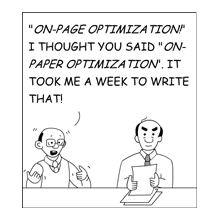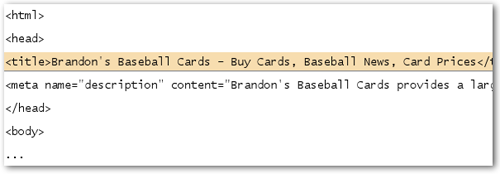 We have discussed on many occasions the fact that Google does care for SEO and that optimized sites rank better in its search results. If you are still in doubt, there is one undeniable and indisputable proof: Google’s Search Engine Optimization Starter Guide (*.pdf), which comes directly from Google with 22 pages of advice for the DIY SEOs and newbies.
We have discussed on many occasions the fact that Google does care for SEO and that optimized sites rank better in its search results. If you are still in doubt, there is one undeniable and indisputable proof: Google’s Search Engine Optimization Starter Guide (*.pdf), which comes directly from Google with 22 pages of advice for the DIY SEOs and newbies.
Today, we’ll highlight the three most important on-page SEO techniques described in this guide – all well-known aspects by experienced SEOs, but important information for those less familiar with what we call “white hat SEO” (SEO techniques that are approved and recommended by the search engines).
Create unique, accurate page titles
The page title is probably the most important on-page SEO aspect – often ignored by many webmasters. Ideally you should have a unique title for each page on your site, as pages with identical titles tend to be treated as “duplicates” by Google (the search engine will only display one of the pages in its results, indexing the duplicates as “supplemental results.”)

The best practices for page title tags are common sense: choose a title that communicates the content of the page and avoid using titles like “untitled” or titles that have nothing to do with the content. Last, but not least: avoid stuffing keywords in your title tags, and avoid ALL CAPS titles.
Another important aspect: if the title is too long (usually more than 60 characters), is that Google will only show a snippet in the search results.
Make use of the “description” meta tag
This is the second most important on-page SEO element (when it comes to what is getting indexed by the search engines). Google might use this as a snipped for your page in the search results – as sometimes Google may choose to use a snippet from your page’s visible text if it matches better the user’s query. Alternatively, if your site is listed in the Open Directory Project, Google might use the description provided there. If you want to prevent Google and other search engines from displaying ODP data, you should add the following meta tag to your pages: <meta name=”robots” content=”NOODP”> (this will only prevent search engines that support meta tags from displaying ODP data).

Meta descriptions should summarize accurately the page’s content, and you should avoid writing descriptions that are unrelated to the content of the page. You should also avoid using descriptions like “this is a webpage”, too short descriptions and keyword-stuffed descriptions. Copying the entire content of the visible text of your page into the description meta tag is a undesired as well: descriptions should usually be less than 160 characters. As with page titles, meta descriptions should be unique for each page of the site too. Using the same meta descriptions “site-wide” or for a large number of pages could force Google to show only one page in the results, sending the rest in the supplemental results index.
Improve the structure of your URLs
Search engine friendly URLs are not a “must” – they are however recommended. Google suggests that these allow for better crawling, and that they appear “friendlier” for those who want to link to your content.
For example, URLs like in the image below can be confusing for the users who would have a hard time memorizing or creating a link to it.

Some users link to pages using the URL as the anchor text (example below) – if the URL contains relevant words, this will help the search engines and other users more than IDs or other oddly named parameters.

So, an ideal URL uses words instead of numbers, session IDs, and etc. Lengthy URLs are not recommended either, and so are generic page names like “page1.html”. Keyword stuffing in the URLs is not allowed.
It is also very important to provide a single version of a URL to reach a document – to prevent users from linking to one URL, and others linking to a different version (thus splitting the reputation of the content between the URLs). Last but not least: do not mix www and non-www versions of URLs in your internal linking structure.
More SEO Techniques from Google’s Search Engine Optimization Starter Guide
This guide describes all major onsite techniques, including site navigation, content, onsite links and best practices for anchor texts, using heading tags appropriately (do not confuse with HTML tags or HTTP headers), image optimization, making use of robots.txt, how and when to use rel=”nofollow” attributes for links, how to promote your site the right way and so on. The guide is particularly important because it can save a lot of time, trouble and even money for those who are looking for the “right answers” when it comes to onsite SEO: there are no secret formulas, as you will see when reading the guide. In addition to the guide, I recommend that you use Google’s Website Optimizer to check your pages to see what on-page changes will produce the best conversion rates with visitors.
Although the guide doesn’t go in-depth describing how to write catchy page titles, and how to write content that sells, the tips provided by Google are what I like to call “timeless SEO” – rules that will never change. I once compared the job of an SEO to that of a book editor: SEO is editing a site, optimizing it, preparing it for the market.
Every site owner who cares about the content of his/her site, about the navigation and the site structure, about how the images harmonize with the text, and so on, does this type of SEO, although some prefer not to call it that. Regardless of terminology, there can be no better source for information about what a search engine wants from your pages than from the source itself. Using the simple techniques provided in these, combined with easy references like the one you are reading, can only lead to better indexing for your sites. It’s as simple as that! At least for the beginner, it is a great place to start.
On-page SEO cartoon courtesy SEOmoz; all other images courtesy Google (*.pdf SEO guide).


